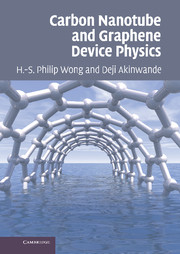Book contents
- Frontmatter
- Contents
- Preface
- 1 Overview of carbon nanotubes
- 2 Electrons in solids: a basic introduction
- 3 Graphene
- 4 Carbon nanotubes
- 5 Carbon nanotube equilibrium properties
- 6 Ideal quantum electrical properties
- 7 Carbon nanotube interconnects
- 8 Carbon nanotube field-effect transistors
- 9 Applications of carbon nanotubes
- Index
9 - Applications of carbon nanotubes
Published online by Cambridge University Press: 05 June 2012
- Frontmatter
- Contents
- Preface
- 1 Overview of carbon nanotubes
- 2 Electrons in solids: a basic introduction
- 3 Graphene
- 4 Carbon nanotubes
- 5 Carbon nanotube equilibrium properties
- 6 Ideal quantum electrical properties
- 7 Carbon nanotube interconnects
- 8 Carbon nanotube field-effect transistors
- 9 Applications of carbon nanotubes
- Index
Summary
The unbeaten path is where discoveries of great ideas can be found.
Introduction
In contemporary fundamental and applied science research, the potential applications and the perceived broader impacts are undoubtedly the primary drivers for expanding the research enterprise. This has certainly been the case for nanotube research. The unique unprecedented properties of CNT, such as their perfect tubular structure, outstanding electrical and thermal conductance, tunable optical properties, and superior mechanical strength and stiffness, have generated great excitement, leading to the pursuit of both fundamental insights of the beauty of nature in reduced dimensions of condensed matter, and the novel applications and technological breakthroughs that can be developed. In essence, the exploration of nanotubes (and other nanomaterials) is to learn about their nature and their interaction with fields and matter that will allow us to synthesize CNTs, design devices, and develop unique materials for next-generation transformative products. This endeavor has brought together many parties across several boundaries of knowledge, from nanomedicine to nanoscience to nanotechnology.
To put CNT in a broader perspective, over the last decade, nanotube applied research and development in academic and industrial laboratories across the world has enjoyed a substantial rise, reflecting a rise in the deeper understanding of the material. Figure 9.1 shows the increase in CNT patent applications and patents issued in the United States. It is an indicator of the growing effort to employ nanotubes in innovative applications. Invariably, many of the applications of CNTs take advantage of their inherent nanoscale dimension, large surface-to-volume ratio, and unique combination of electrical, optical, thermal, and structural properties.
- Type
- Chapter
- Information
- Carbon Nanotube and Graphene Device Physics , pp. 233 - 248Publisher: Cambridge University PressPrint publication year: 2010
- 1
- Cited by



